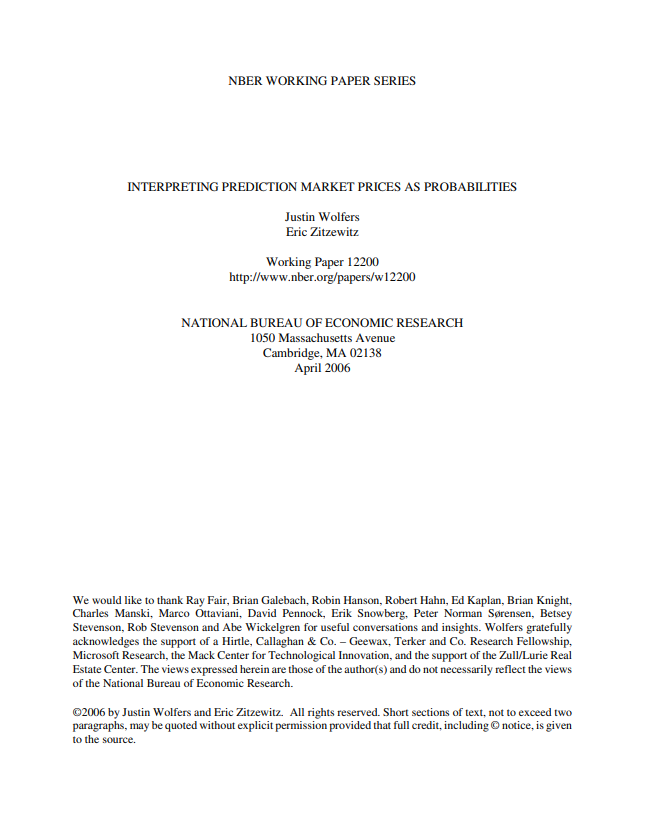Interpreting prediction market prices as probabilities by Justin Wolfers, Eric Zitzewitz

1. Introduction
In a provocative recent paper, Charles Manski (2004) asked “What is the logical
basis for interpreting the price of an all-or-nothing futures contract as a market
probability that the event will occur?” Moreover, he notes that “recent papers on
prediction markets provide no formal analysis showing how such markets aggregate
information or opinions.” Manski poses an excellent question, and he highlights an
important topic for research. As prediction markets have become of more widespread
interest, the prices of contracts tied to events as diverse as the re-election of President
Bush, the ouster of Saddam Hussein, next month’s non-farm payrolls number, or the
success of specific products have been interpreted in both academic and popular
discussion as though interchangeable with “the market’s beliefs”.
This paper presents an initial response to Manski’s challenge, providing a formal
model which provides a plausible microfoundation under which one can treat prediction
market prices as probabilities. Further, we explore deviations from our baseline model,
and show that for most plausible parameters, prediction market prices at least
approximate the central tendency of the distribution of beliefs of traders.
The specific
model offered by Manski is a special case of our model, and while he emphasizes special
assumptions that can lead his model to yield counter-intuitive results, we show that
sensible distributions of preferences and beliefs yield more intuitive results.
We proceed as follows. The next section sketches two very simple models in
which prediction market prices coincide exactly with the mean of the belief among
traders. The following section generalizes the model, showing that prediction market
prices can deviate from mean beliefs, but that this deviation is typically small. The extent
of the deviation depends crucially on how widely dispersed beliefs are, and so in the final
section we present field evidence on this point. To preview, our results suggest that
while prediction market prices and mean beliefs may diverge, they are typically very
close. We interpret our results as providing a microfoundation for the claim that
prediction markets (approximately) efficiently aggregate beliefs.
2. Two Simple Models
We consider a simple prediction market in which traders buy and sell an all-or-
nothing contract (a binary option) paying $1 if a specific event occurs, and nothing
otherwise. There is heterogeneity in beliefs among the trading population, and following
Manski’s notation, we denote trader j’s belief that the event will occur as qj. These
beliefs are orthogonal to wealth levels (y), and are drawn from a distribution, F(q).
Individuals are price-takers and trade so as to maximize their subjectively expected
utility. Wealth is only affected by the event via the prediction market, so there is no
hedging motive for trading the contract.
We first consider the case where traders have log utility, and we endogenously derive
their trading activity, given the price of the contract is π. Thus, in deciding how many
contracts, x, to buy, traders solve the following problem:
Interpreting prediction market prices as probabilities by Justin Wolfers, Eric Zitzewitz




